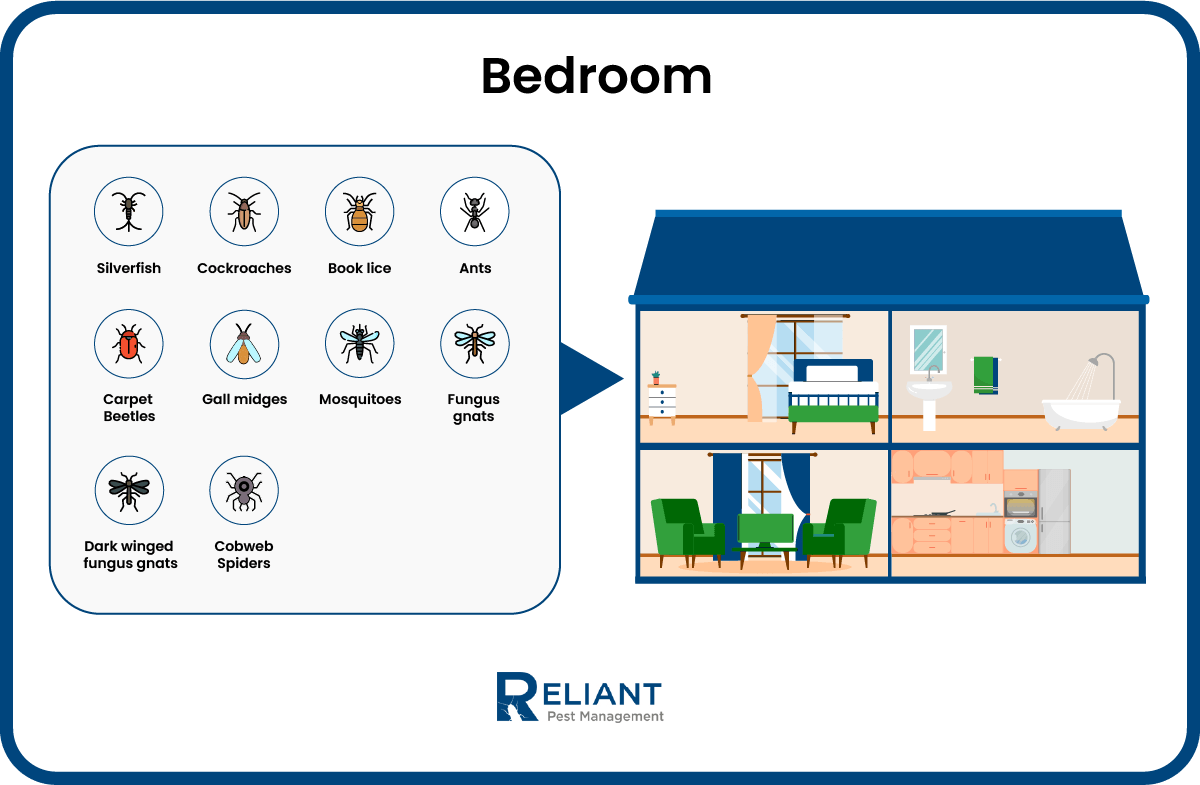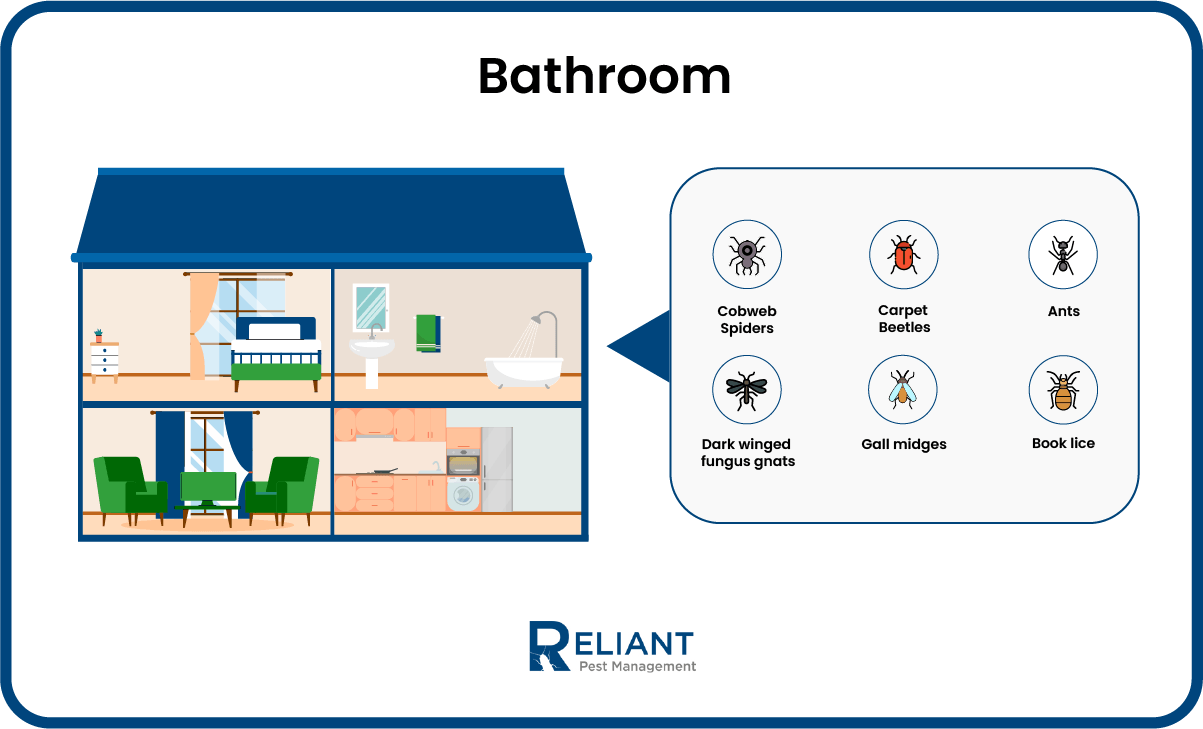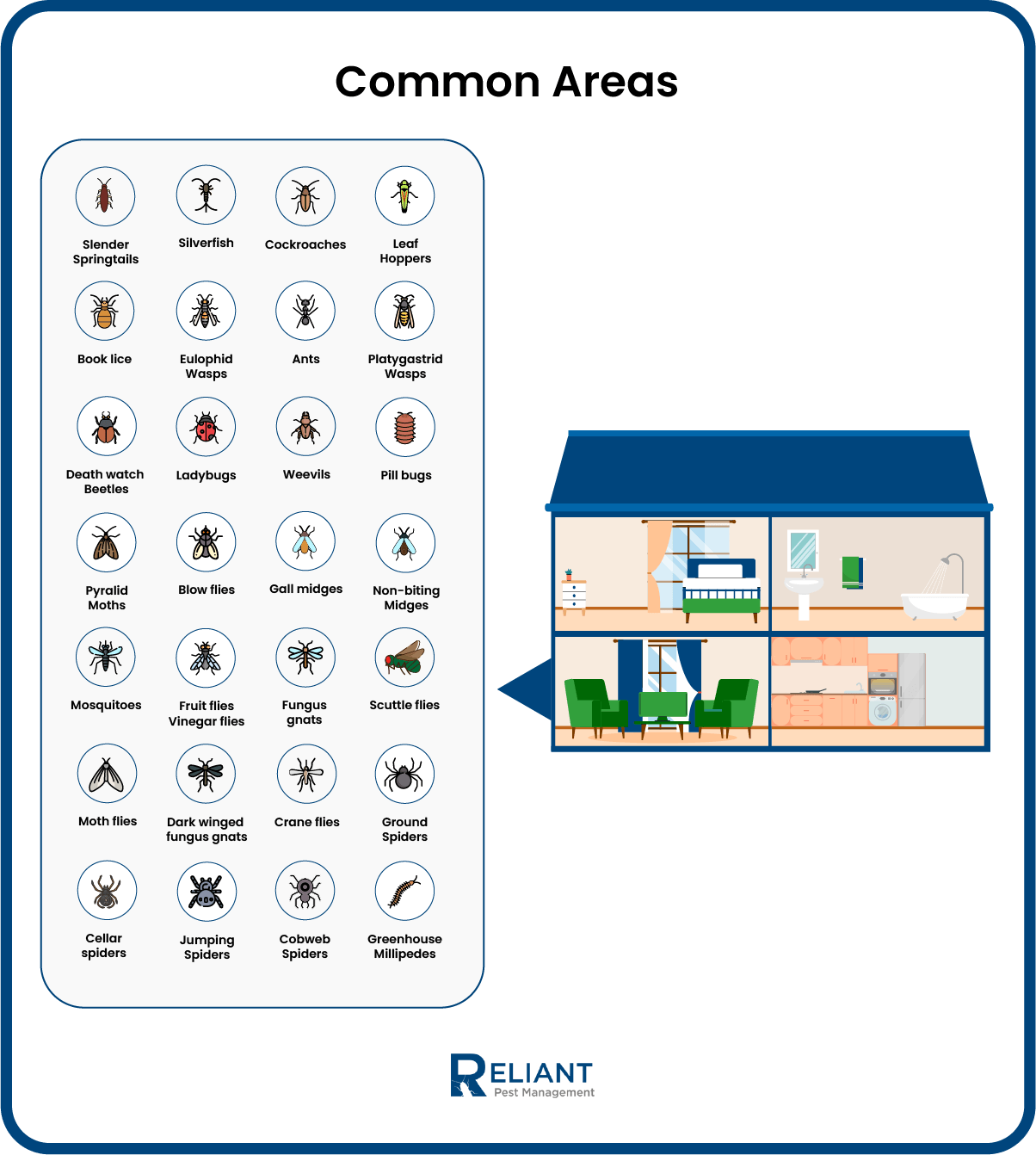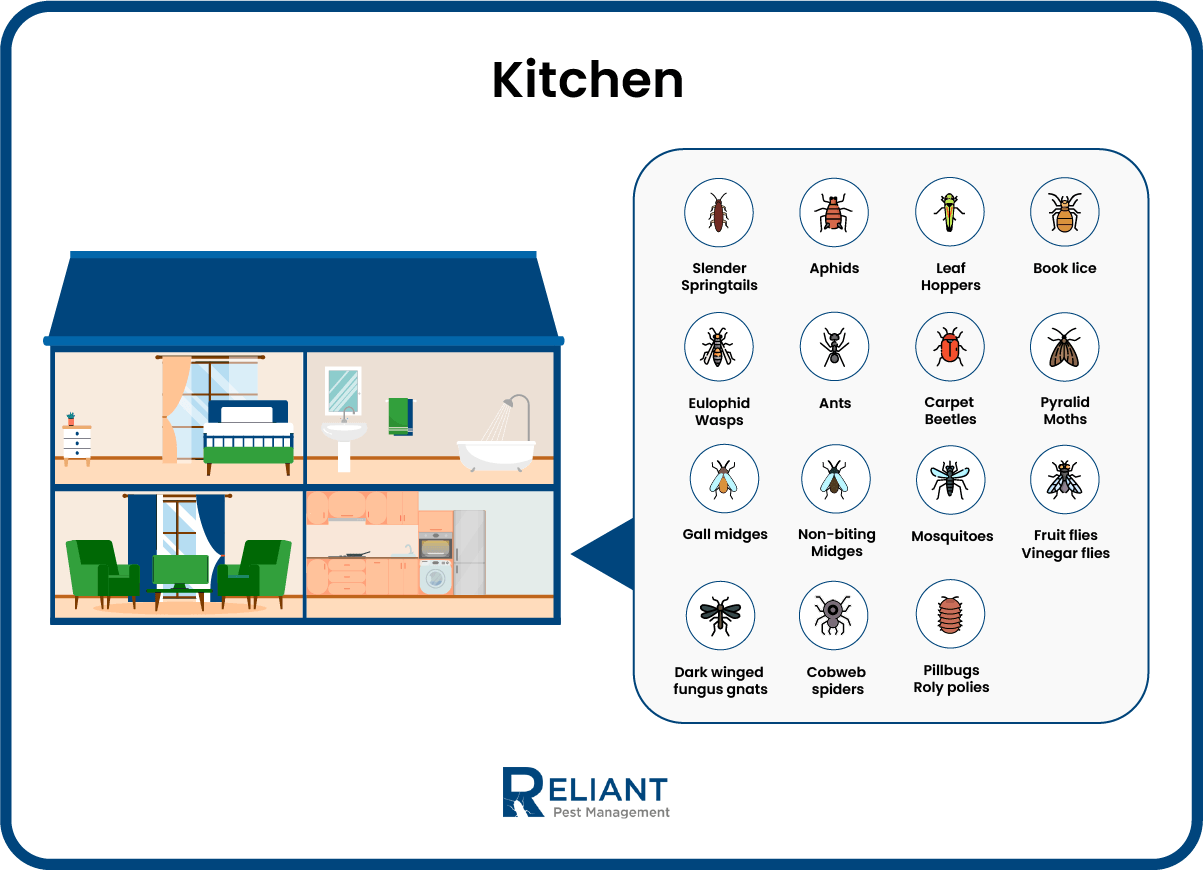Unless you’re an entomologist, the thought of sharing your home with insects might not be a pleasant one. But the truth is, there are probably more insects living in your house right now than you realize.
In fact, the average home has more than 100 different types of bugs living in it!
So, let’s take a closer look at some of the most common insects you’ll find in your home so you can take pest control steps to get rid of them once and for all.
Click on the interactive chart below to get a closer look at some of the insects you might find in your home.
Key Takeaways
- There are several types of pests you will find just about anywhere in your home like cockroaches, ants, and mosquitoes.
- Other pests, like book lice or carpet beetles, might be more likely to hang around in common areas.
- Some pests, like millipedes, prefer the damp, dark areas of your home (such as the bathroom).
Bedroom
From the cracks in your floorboards to the gaps between your furniture, there are countless hiding spots for bugs to take refuge in your bedroom. Plus, bedrooms are often full of dust, which provides a food source for many types of insects. And finally, most bedrooms are located near other rooms in the house (such as the kitchen or bathroom), making it easy for pests to travel from one room to another.
| Silverfish | Come inside on paper products. | •Harmless •Eat books, wallpaper glue, cereal boxes, etc. |
| Cockroaches | Enter through small cracks and crevices. | •Harmful •Contaminate food with bacteria and triggers allergies or asthma attacks in sensitive people. |
| Book lice | Enter through cracks and crevices in the foundation or walls. | •Harmless •Can damage books and other paper products. |
| Ants | Enter through cracks in the foundation or gaps around doors and windows. | •Harmless •Some species of ants can cause damage to your home by excavating tunnels in wood or biting through electrical wires. |
| Carpet beetles | Enter through cracks and crevices in the foundation or through open doors and windows. | •HarmlessAbility to cause damage to household belongings, no harm to humans |
| Gall midges | Come inside accidentally and are attracted to moisture. | •Harmful and beneficial at the same time •Serve as food for other animals •Their larvae can damage plants and they can be a nuisance. |
| Mosquitoes | Come in through open doors and windows, cracks and crevices in the exterior of the home, or by hitchhiking on pets or visitors. | •Harmful •Their bites can transmit diseases like West Nile Virus or Zika. |
| Fungus gnats | Come inside via the soil of infested houseplants. | •Harmless •Some may occasionally feed on roots of plants and spread disease to those plants. |
| Dark-winged fungus gnats | Attracted to decomposing organic matter. | •Mostly benign •Some may occasionally feed on the roots of plants and spread disease to those plants. |
| Cobweb spiders | Unintentionally brought into homes on clothing or luggage. | •Not harmful to humans and can help to control the population of other household pests. |
–
Keep bugs out of your bedroom
We provide pest control services across central Texas, including Houston, Austin, San Antonio, and more. Get your 1st service for $79 and 1 free year of termite protection with our Elite Pest Defense Plan.
–
Bathroom
The bathroom is one of the most commonly used rooms in any home, and it’s also one of the most likely places to find pests. From ants and cockroaches to spiders and silverfish, a variety of creatures are drawn to the humid, dark environments found in bathrooms. In many cases, these pests are simply looking for a source of water or shelter. However, they can also be attracted by the food left behind on counters and in sinks.
| Cobweb spiders | Unintentionally brought into homes on clothing or luggage. | •Harmless •Can help to control the population of other household pests. |
| Carpet beetles | Enter through cracks and crevices in the foundation or through open doors and windows. | •Harmless •Ability to cause damage to household belongings. |
| Ants | Enter through cracks in the foundation or gaps around doors and windows. | •Harmless •Some species of ants can cause damage to your home by excavating tunnels in wood or biting through electrical wires. |
| Dark-winged fungus gnats | Attracted to decomposing organic matter. | •Harmless •Some may occasionally feed on the roots of plants and spread disease to those plants. |
| Gall midges | Come inside accidentally and are attracted to moisture. | •Harmless •Serve as food for other animals | •Their larvae can damage plants and they can be a nuisance. |
| Book lice | Enter through cracks and crevices in the foundation or walls. | •Harmless •Can damage books and other paper products. |
Common Areas
Your living room is a gathering place for your family and friends. It’s also a common gathering place for bugs. Why are there so many bugs in your living room? There are a few reasons.
First, your living room is usually one of the warmest rooms in your house. Bugs are attracted to warmth. Second, there are usually lots of food and water sources in your living room. Third, there are usually lots of hiding places in your living room.
Finally, your living room is usually full of people coming and going. Bugs can hitch a ride into your living room on clothing or shoes.
| Slender springtails | Found in damp basements, crawl spaces, and kitchens, and they can enter homes through small cracks and crevices. | •Harmless •Feed on mold and mildew |
| Silverfish | Carried inside in paper products. | •Harmless •Eat books, wallpaper glue, cereal boxes, etc. |
| Cockroaches | Get in through small cracks and crevices. | •Harmful •Contaminate food with bacteria •Triggers allergies or asthma attacks in sensitive people. |
| Leafhoppers | Attracted to porch lights or windows, and they can enter through open doors and windows. | •Harmless •Can be a nuisance. |
| Book lice | Enter through cracks and crevices in the foundation or walls. | •Harmless •Can damage books and other paper products. |
| Eulophid wasps | Find their way into homes through open doors or windows. | •Beneficial •Play an important role in controlling pest populations. |
| Ants | Enter through cracks in the foundation or gaps around doors and windows. | •Harmless •Some species of ants can cause damage to your home by excavating tunnels in wood or biting through electrical wires. |
| Platygastrid wasps | Come into homes by accident, usually through an open door or crack. | •Beneficial, but can be a nuisance |
| Death watch beetles | Attracted to light, which is why they are often seen in homes at night. | •Harmless •Not harmful to humans, but cause serious damage to wooden structures. |
| Ladybugs | Enter through any small crack or opening. | •Beneficial |
| Weevils | Enter homes through tiny cracks and crevices as well as in bags of dry goods (like flour). | •Mostly harmless, but can contaminate food |
| Carpet beetles | Enter homes through cracks and crevices in the foundation or through open doors and windows. | •Harmless •Do not pose a health risk to humans |
| Click beetles | Attracted to light Often enter homes through open doors and windows. | •Harmless |
| Scarab beetles | Enter homes accidentally, through cracks and gaps. | •Harmless |
| Darkling beetles | Enter homes through gaps around doors and windows. | •Harmless •Can be a nuisance because they emit a foul odor when disturbed. |
| Pyralid moths | Drawn to lights | •Harmless |
| Blow flies | Attracted to rotting food and other sources of decomposing matter | •Harmful •Carry disease-causing bacteria on their bodies. |
| Gall midges | Come inside accidentally and are attracted to moisture. | •Harmless •Serve as food for other animals •Their larvae can damage plants and they can be a nuisance. |
| Non-biting midges | Come into homes by accident and are often found near damp areas. | •Harmless |
| Mosquitoes | Come in through open doors and windows, cracks and crevices in the exterior of the home, or by hitchhiking on pets or visitors. | •Harmful •Their bites can transmit diseases like West Nile Virus or Zika. |
| Fruit flies, vinegar flies | Enter via open doors or windows. Attracted to ripened fruits and vegetables. | •Potentially harmful •Fruit flies can contaminate food with bacteria. |
| Fungus gnats | Come inside via the soil of infested houseplants. | •Harmless |
| Scuttle flies | Enter through cracks in doors and windows. | •Harmless |
| Moth flies | Attracted to moisture | •Harmless |
| Dark-winged fungus gnats | Attracted to decomposing organic matter. | •Harmless •Some may occasionally feed on the roots of plants and spread disease to those plants. |
| Crane flies | Attracted to light. Often seen near windows and porch lights. | •Harmless |
| Ground spiders | Come in through cracks and crevices in the foundation or walls. Carried in on clothing or boxes. | •Beneficial |
| Cellar spiders | Come into homes accidentally. | •Beneficial •Some people may be allergic to their venom and experience symptoms such as swelling and itching |
| Jumping spiders | Come in through open doors or windows or cracks and crevices. | •Harmless |
| Cobweb spiders | Unintentionally brought into homes on clothing or luggage. | •Beneficial |
| Greenhouse millipedes | Come inside accidentally. | •Beneficial |
| Pillbugs | Enter homes through cracks in the foundation or openings around doors and windows. | •Harmless |
Kitchen
| Slender springtails | Found in damp basements, crawl spaces, and kitchens, and they can enter homes through small cracks and crevices. | •Harmless |
| Aphids | Come into the home accidentally through open doors and windows. Sometimes come in on infested plants. | •Harmless unless you have a garden – they can harm the plants. |
| Leafhoppers | Attracted to porch lights or windows. | •Harmless |
| Book lice | Enter through cracks and crevices in the foundation or walls. | •Harmless •Can damage books and other paper products. |
| Eulophid wasps | Find their way into homes through open doors or windows. | •Beneficial •Play an important role in controlling pest populations. |
| Ants | Enter through cracks in the foundation or gaps around doors and windows | •Harmless •Some species of ants can cause damage to your home by excavating tunnels in wood or biting through electrical wires. |
| Carpet beetles | Enter through cracks and crevices in the foundation or through open doors and windows. | •Harmless •Do not pose a health risk to humans |
| Pyralid moths | Drawn to lights. | •Beneficial |
| Gall midges | Come inside accidentally and are attracted to moisture. | •Harmless •Serve as food for other animals •Their larvae can damage plants and they can be a nuisance. |
| Non-biting midges | Come into homes by accident and are often found near damp areas. | •Harmless |
| Mosquitoes | Come in through open doors and windows, cracks and crevices in the exterior of the home, or by hitchhiking on pets or visitors. | •Harmful •Their bites can transmit diseases like West Nile Virus or Zika. |
| Fruit flies, vinegar flies | Open doors or windows. Attracted to ripened fruits and vegetables. | •Potentially harmful •Fruit flies can contaminate food with bacteria. |
| Dark-winged fungus gnats | Attracted to decomposing organic matter. | •Harmless •Some may occasionally feed on the roots of plants and spread disease to those plants. |
| Cobweb spiders | Unintentionally brought into homes on clothing or luggage. | •Not harmful to humans and can actually be beneficial. They help to control the population of other household pests. |
| Pillbugs, roly polys | Enter homes through cracks in the foundation or openings around doors and windows. | •Harmless |
–
Keep critters out of your kitchen
We provide pest control services across central Texas, including Houston, Austin, San Antonio, and more. Get your 1st service for $79 and 1 free year of termite protection with our Elite Pest Defense Plan.
–
The Food Chain of Your Home

Most of us don’t think about the complex network of life going on inside our homes. We’re too busy living our lives to worry about the cockroaches scuttling around in the walls or the ants raiding our pantries. But these insects play an important role in the delicate ecosystem of your home. And that ecosystem is more important than you might think.
The insects in your home are engaged in a constant battle for survival. Some are predators, preying on other insects for food. Some are scavengers, feeding on any organic material they can find. Others are parasites, leeching off their hosts for sustenance. This intricate web of life keeps populations in check and helps to ensure a healthy balance. However, this balance can be easily disrupted.
Infestations happen when one species gets out of control and starts to overwhelm the others. This can happen for a variety of reasons, including changes in temperature, a lack of food, or an influx of new insects. If left unchecked, an infestation can quickly spiral out of control and become a serious problem. That’s why it’s important to be proactive and take steps to prevent them from happening in the first place.
Where You Live Matters
The type of pests, and the severity of the infestation, can vary greatly depending on your location. That’s why it’s important to be aware of the unique pest pressures in your area and to take steps to protect your home or business accordingly. Here’s a quick guide to some of the most common types of pests and where they’re most likely to be found.
Urban
City dwellers have to contend with all sorts of pests, from rats and cockroaches to bedbugs and pigeons. These pests are attracted to urban areas for many reasons, including the availability of food, shelter, and water.
And because cities are so densely populated, it’s easy for pests to spread from one building to another. That’s why it’s so important for city dwellers to be vigilant about controlling pests and to call in a professional at the first sign of an infestation.
Rural
Rural homeowners have to deal with different types of pests than their urban counterparts, including deer ticks, mosquitoes, termites, and rabbits. These pests are attracted to rural areas for different reasons than those that like cities – usually because there’s more open space and fewer people around.
That said, even rural homeowners need to be on the lookout for pests and should take steps to prevent them from taking over their property.
Cooler Climate
Pests don’t just thrive in warm weather – some of them actually prefer cooler climates. So if you live in a cooler climate zone, be on the lookout for ants, rodents, spiders, and cockroaches. These pests will seek out any warm place they can find when the weather gets cold, which means they’ll likely end up in your home if you’re not careful.
To prevent an infestation, seal up any cracks or openings in your home’s exterior, and make sure your doors and windows fit snugly in their frames.
Warmer Climate
If you live in a warmer climate zone, you’ll want to be on the lookout for different types of pests than those that like cooler climates – namely snakes, scorpions, centipedes, millipedes, and termites.
These insects and animals will typically only come into your home if it’s too hot or too dry outside, so if you live in a warmer climate zone, make sure your home is well-sealed against the elements. You should also keep an eye out for signs of termite damage (like hollowed-out wood) and call a professional exterminator if you spot anything suspicious.
High Altitude
If you live at high altitude, you’re likely to encounter several different types of pests. One of the most common pests you’ll find is the mosquito. These pesky insects are attracted to standing water, so be sure to empty any pots or barrels that may be collecting water around your home.
Low Altitude
If you live at low altitude, you’ll likely encounter different types of pests than if you lived at high altitude. Some of the most common include termites and ants.
Conclusion
Most people don’t enjoy sharing their homes with insects—but the truth is, there are probably more bugs living in your house right now than you realize. By being aware of the most common house pests, you can take steps to get rid of them.
After all, they aren’t paying any rent, so there’s no reason to let them hang out for free!
–
Keep all the bugs far far away from your home
We provide pest control services across central Texas, including Houston, Austin, San Antonio, and more. Get your 1st service for $79 and 1 free year of termite protection with our Elite Pest Defense Plan.
–



